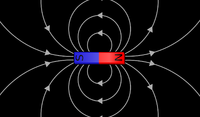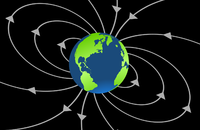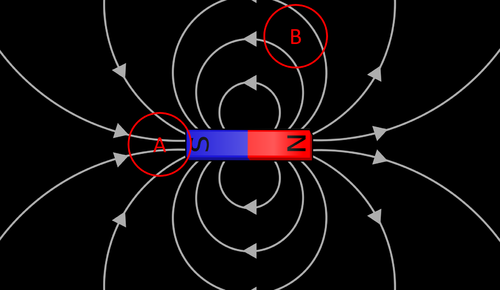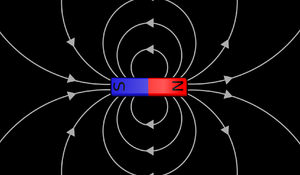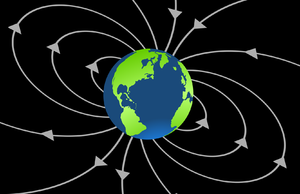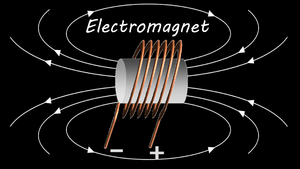Key Stage 3
Meaning
A magnetic field is the region around a magnet that affects other magnets or magnetic materials.
About Magnetic Fields
- A magnetic field can be shown by placing a magnet under paper and then sprinkling iron filings on the paper.
- A magnetic field is strongest at the poles of the magnet.
- When a magnetic field is drawn the lines are extend from the North Seeking Pole to the South Seeking Pole of the magnet. The arrows on the field lines point from North to South.
|
|
|
| The magnetic field lines point from north to south.
|
Iron filings are a magnetic material so they can be used to show the magnetic field.
|
Examples
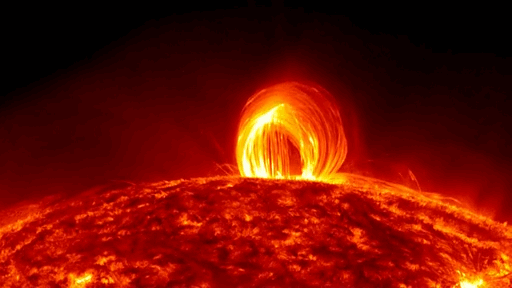
|
| This animation shows a solar flare curving back to The Sun due to a strong magnetic field
|
Key Stage 4
Meaning

This animation shows a solar flare curving back to
The Sun due to a strong
magnetic field.
A magnetic field is the region around a magnet in which magnets or magnetic materials experience a force.
About Magnetic Fields
- A magnetic field can be shown by placing a magnet under paper and then sprinkling iron filings on the paper.
|
|
|
| The magnetic field lines point from north to south.
|
Iron filings are a magnetic material so they can be used to show the magnetic field.
|
- When a magnetic field is drawn the lines are extend from the North Seeking Pole to the South Seeking Pole of the magnet. The direction of the magnetic field is shown by the arrows on the field lines point from North to South.
- The strength of magnetic field is shown by how close together the magnetic field lines are.
- A magnetic field is strongest at the poles of the magnet.
|
|
| The region marked A is in a stronger magnetic field than region B as shown by the number of field lines enclosed in the area.
|
Examples
References
AQA
- Magnetic fields, pages 214-229, GCSE Physics; Third Edition, Oxford University Press, AQA
- Magnetic fields, pages 216, 217, GCSE Combined Science Trilogy; Physics, CGP, AQA
- Magnetic fields, pages 222-3, GCSE Physics, Hodder, AQA
- Magnetic fields, pages 276-7, GCSE Combined Science Trilogy 2, Hodder, AQA
- Magnetic fields, pages 289, 290, GCSE Physics; The Complete 9-1 Course for AQA, CGP, AQA
- Magnetic fields, pages 92-98, GCSE Physics; The Revision Guide, CGP, AQA
- Magnetic fields; Around a current-carrying wire, pages 278, GCSE Combined Science Trilogy 2, Hodder, AQA
- Magnetic fields; around a solenoid, page 225, GCSE Physics, Hodder, AQA
- Magnetic fields; Around a solenoid, pages 279, GCSE Combined Science Trilogy 2, Hodder, AQA
- Magnetic fields; combination of, page 228, GCSE Physics, Hodder, AQA
- Magnetic fields; Combination of, pages 281, GCSE Combined Science Trilogy 2, Hodder, AQA
- Magnetic fields; field lines, page 92, GCSE Physics; The Revision Guide, CGP, AQA
- Magnetic fields; field strength, pages 92-94, GCSE Physics; The Revision Guide, CGP, AQA
- Magnetic fields; Fleming`s left-hand rule, pages 281-2, GCSE Combined Science Trilogy 2, Hodder, AQA
- Magnetic fields; Flemings left-hand rule, page 229, GCSE Physics, Hodder, AQA
- Magnetic fields; flux density, page 94, GCSE Physics; The Revision Guide, CGP, AQA
- Magnetic fields; induced potential difference, pages 232-3 GCSE, GCSE Physics, Hodder, AQA
- Magnetic fields; motor effect, page 228, GCSE Physics, Hodder, AQA
- Magnetic fields; near a straight wire, page 224, GCSE Physics, Hodder, AQA
- Magnetic fields; of the Earth, page 217, GCSE Combined Science Trilogy; Physics, CGP, AQA
- Magnetic fields; of the earth, page 290, GCSE Physics; The Complete 9-1 Course for AQA, CGP, AQA
- Magnetic fields; of the Earth, page 92, GCSE Physics; The Revision Guide, CGP, AQA
Edexcel
- Magnetic fields, page 133, 168-169, GCSE Physics, Pearson Edexcel
- Magnetic fields, page 267, GCSE Physics, CGP, Edexcel
- Magnetic fields, pages 195, 197, GCSE Combined Science; The Revision Guide, CGP, Edexcel
- Magnetic fields, pages 375, 402-403, GCSE Combined Science, Pearson Edexcel
- Magnetic fields, pages 85, 87, GCSE Physics; The Revision Guide, CGP, Edexcel
- Magnetic fields; flux density, page 274, GCSE Physics, CGP, Edexcel
- Magnetic fields; forces, pages 268, 269, 273-275, GCSE Physics, CGP, Edexcel
- Magnetic fields; materials, page 267, GCSE Physics, CGP, Edexcel
- Magnetic fields; of bar magnets, page 268, GCSE Physics, CGP, Edexcel
- Magnetic fields; of current-carrying wires, page 270, GCSE Physics, CGP, Edexcel
- Magnetic fields; of solenoids, pages 270, 271, GCSE Physics, CGP, Edexcel
- Magnetic fields; uniform fields, page 268, GCSE Physics, CGP, Edexcel
OCR
- Magnetic fields, pages 120-123, 126-128, Gateway GCSE Physics, Oxford, OCR
- Magnetic fields, pages 183, 184, Gateway GCSE Combined Science; The Revision Guide, CGP, OCR
- Magnetic fields, pages 52-57, Gateway GCSE Physics; The Revision Guide, CGP, OCR




